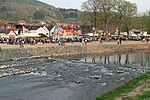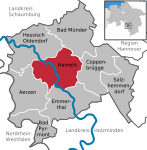Reich Harvest Thanksgiving Festival

The Reich Harvest Thanksgiving Festival (German: Das Reichserntedankfest) was a monumental Nazi German celebration of the peasantry and the German farmers. The festivals ran from 1933 to 1937 on the Bückeberg, a hill near the town of Hamelin. Most festivals occurred every October, with the 1934 festival commencing 30 September. The official purpose of the festival was the recognition of the achievements of the German farmers, whom the Nazis called the Reichsnährstand (the Reich's Food Estate). The celebration was also used by the Nazis as a propaganda tool to showcase the connection between Führer Adolf Hitler and the German people. The festival was part of a cycle of Nazi celebrations which included the annual party rally at Nuremberg, Hitler's birthday celebrations and other important events on the Nazi calendar.In 1937, the festival was attended by about 1.2 million people, culminating with Hitler walking through the Führerweg (Führer's way) to the harvest monument, in the form of an altar, to receive the harvest crown from the Farmers' Estate on behalf of the German people. The festival was attended by more people than any other Nazi ceremony or ritual activity, including the party rally at Nuremberg.In addition to its agricultural theme, the festival was used by the Nazis to increase the contact of the Führer with the masses and to demonstrate the Reich's military prowess. From 1935, the Wehrmacht staged mock battles at the festival with the participation of up to 10,000 soldiers, airplanes and panzers. In 1933, during his inaugural speech at the festival, Hitler announced the passage of a new law, the Reichserbhofgesetz, the State Hereditary Farm Law, which provided safeguards for the integrity of ownership of some family farms.
Excerpt from the Wikipedia article Reich Harvest Thanksgiving Festival (License: CC BY-SA 3.0, Authors, Images).Reich Harvest Thanksgiving Festival
Bückebergstraße,
Geographical coordinates (GPS) Address Nearby Places Show on map
Geographical coordinates (GPS)
| Latitude | Longitude |
|---|---|
| N 52.0547 ° | E 9.4014 ° |
Address
Dokumentations- und Lernort Bückeberg
Bückebergstraße
31860 , Hagenohsen
Lower Saxony, Germany
Open on Google Maps








